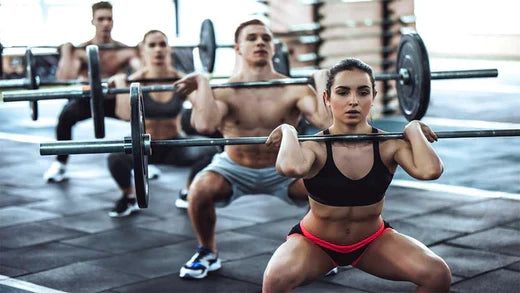Exercices Crossfit : comment améliorer vos temps de WOD

Exercices de précision pour améliorer vos performances WOD
Vous avez du mal à gagner en vitesse pendant votre entraînement du jour ? Vous avez l'impression que, malgré tous vos exercices de CrossFit, vous ne constatez aucune amélioration ? Pas d'inquiétude ; la plupart des CrossFitteurs se heurtent inévitablement à un mur et n'arrivent pas à le surmonter. Voici quelques exercices de CrossFit pour améliorer vos temps de WOD.
RETOUR AUX BASES
Pour améliorer vos temps de WOD, le meilleur point de départ est votre point de départ. Même les haltérophiles les plus expérimentés tombent dans le piège du confort : ils effectuent un exercice tellement de fois qu'ils ne remettent pas en question leur technique ni leur posture.
Croire que vous exécutez chaque squat, chaque clean, chaque snatch et chaque muscle-up à la perfection est une erreur. Abordez chaque séance d'entraînement avec l'esprit d'un débutant et soyez ouvert à l'apprentissage de nouvelles astuces pour des exercices déjà connus, comme les mouvements essentiels du CrossFit suivants :
- Squat au poids du corps (également appelé Air Squat)
- Squat avec barre au-dessus de la tête
- Squat avant
- Soulevé de terre
- Soulevé de terre sumo
- Presse à épaules
- Pousser Appuyer
- Pousser-secousse
- Tirage élevé
- Nettoyage avec médecine-ball
Cela dit, nous vous recommandons de revoir les exercices fondamentaux du CrossFit avec votre entraîneur ou un ami expérimenté. Demandez-lui d'observer votre technique et de signaler vos éventuelles erreurs. Si vous n'êtes pas disponible, enregistrez-vous, visionnez votre performance et notez les erreurs à corriger.
AMÉLIOREZ VOS POINTS FAIBLES
Pour poursuivre sur le point précédent, avoir un mentor, un observateur ou une caméra qui surveille votre entraînement CrossFit vous permettra de repérer les points à améliorer. Si votre technique est en baisse ou si vous constatez des problèmes de surcompensation, ajustez vos entraînements CrossFit pour y remédier. Voici quelques-uns des points faibles les plus courants des CrossFitters et comment les renforcer.
Traction à la barre : Si vous avez du mal à vous déplacer et à vous tortiller lors de cette ascension, essayez l'exercice suivant : effectuez des tractions négatives ou excentriques sur des anneaux plusieurs fois par semaine à la fin de votre séance. Effectuez-en autant que possible en vous élevant avec une chaise ou une boîte. Résistez et luttez pour rester debout tout en descendant lentement.
Arraché : De nombreux CrossFitters constatent qu'ils sont plus faibles en position overhead lors d'un arraché. La solution ? Essayez d'ajouter des squats overhead à votre entraînement. En partant d'un rack à squats, vous serez déjà en position overhead. Les squats overhead augmenteront considérablement votre mobilité et la force du bas du corps, ce qui facilitera votre arraché.
Soulevés de terre : Que vous soyez adepte du CrossFit, du bodybuilder ou du powerlifting, le soulevé de terre est difficile à maîtriser, mais il constitue l'un des meilleurs exercices à intégrer à votre entraînement. Une astuce pour progresser ? Essayez le soulevé de terre unijambiste. En isolant les ischio-jambiers, les fessiers, les mollets et les fléchisseurs de la hanche, vous constaterez que votre force et votre stabilité s'amélioreront avec un soulevé de terre classique.
Vous pouvez également utiliser notre liste de contrôle de soulevé de terre pour améliorer votre forme et votre force.
CONCENTREZ-VOUS SUR LA FORCE DE PRÉHENSION
Un autre point faible courant chez tous les types d'haltérophiles, notamment en CrossFit, est la force de préhension. Il n'y a rien de pire que de savoir qu'il vous reste encore quelques répétitions, mais que votre prise lâche avant d'atteindre le muscle ciblé.
Il existe deux méthodes simples pour augmenter votre force de préhension, que vous pouvez commencer dès aujourd'hui : tout d'abord, utilisez des barres et des haltères plus épais. Il a été démontré que l'entraînement avec des barres épaisses augmente considérablement la force de préhension, ce qui améliore considérablement les performances.
Si vous n'avez pas accès à des barres et des haltères épais, utilisez des poignées épaisses . Vous pouvez les glisser sur des barres et des haltères traditionnels pour une prise épaisse instantanée.
Une autre façon d'améliorer la force de préhension est de pratiquer des exercices axés sur la préhension. Trois fois par semaine, effectuez l'entraînement suivant après votre entraînement CrossFit :
- Marche du fermier à prise épaisse : à l'aide d'un haltère à barre épaisse ou d'un haltère à prise épaisse , effectuez 3 séries de marches du fermier de 60 secondes.
- Tractions à la serviette sur un bras : Commencez par attacher une serviette à une barre de traction. Tenez la serviette dans la main gauche et la barre dans la main droite. Répétez 5 fois avec la serviette dans la main gauche. Ensuite, changez de position et effectuez 5 répétitions supplémentaires avec la serviette sur le côté droit. Réalisez 3 séries.
- Maintiens en suspension avec barre épaisse : À l'aide d'une barre de traction à poignées épaisses ou de poignées épaisses , enroulez vos mains autour de la barre, puis relevez vos pieds. Maintenez la position aussi longtemps que possible. Effectuez une série.
En plus d’améliorer vos temps de WOD, l’entraînement de la force de préhension présente plusieurs autres avantages, notamment la prévention des blessures et l’amélioration des schémas de mouvement fonctionnels.
PASSEZ À L'AÉROBIE POUR AMÉLIORER L'ANAÉROBIE
Après avoir maîtrisé les exercices de base du CrossFit et corrigé vos points faibles, il sera temps de vous concentrer sur votre capacité aérobique ou endurance.
Lors d'un WOD, vous vous appuyez principalement sur votre capacité anaérobie. Vous effectuez des accélérations rapides et des exercices de puissance qui vous épuisent assez rapidement. Pour durer plus longtemps et améliorer votre WOD, vous devez vous concentrer sur l'augmentation de votre endurance aérobie, qui permet de maintenir une activité sur une longue période, comme un jogging. Voici quelques excellents moyens d'augmenter votre capacité aérobie :
Sprints hybrides : combiner exercices aérobiques et anaérobiques est un excellent moyen d'améliorer les deux. Réglez un chronomètre ou un téléphone pour compter facilement les secondes. Courez à un rythme confortable pendant 50 secondes par minute. Pendant les 10 secondes restantes, sprintez à 90 % d'intensité. Répétez cet exercice jusqu'à 10 minutes.
Concentrez-vous sur le maintien de l'excentrique : lors d'une séance d'haltérophilie ou d'un WOD CrossFit, bougez lentement pendant la phase de descente ou d'excentrique. Vous pouvez utiliser l'explosion pendant la phase de montée, mais à partir de là, marquez une pause et prenez jusqu'à cinq secondes pour revenir à la position de départ.
Collines et randonnées : Un excellent moyen d'améliorer considérablement sa capacité aérobie et sa force musculaire est de courir en côte ou de randonner en montagne. Vous atteindrez facilement votre fréquence cardiaque cible pour améliorer votre capacité aérobie en gravissant une colline ou un flanc de montagne. Mieux encore, la randonnée nécessite une longue montée. Restez stable et poursuivez votre chemin.
LIFT POUR LA FORCE
Lors des journées cardio ou de quelques WOD par semaine, vous pouvez vous concentrer sur l'amélioration de votre capacité aérobie, mais lors de vos entraînements intensifs, privilégiez la force. En augmentant votre force et votre capacité aérobie, vous pourrez soulever davantage de poids pendant plus longtemps sans risque de blessure. Autrement dit, vous obtiendrez de meilleurs temps aux WOD.
Pour développer votre force, vous devrez utiliser les bonnes variables aiguës ainsi que des exercices éprouvés comme le squat, le soulevé de terre et le développé couché. L'entraînement axé sur la force se décompose généralement comme suit :
- Concentrez-vous sur les exercices qui sollicitent le plus grand nombre de groupes musculaires
- Utilisez 75 à 85 % de votre maximum d'une répétition pendant les levées
- Effectuez 5 à 8 séries de 3 à 6 répétitions par exercice
- Prenez des pauses plus longues, mais pas plus de 120 secondes
- Lors de la dernière série d'exercices composés, terminez par des séries dégressives (terminer une série, baisser le poids, terminer une autre série, baisser à nouveau le poids, etc.)
Essayez d'utiliser des variables aiguës axées sur la force lors de deux séances d'entraînement par semaine. Notez la charge que vous utilisez afin de suivre vos progrès au fil des semaines.
NE JAMAIS NÉGLIGER LA RÉCUPÉRATION
Finalement, le meilleur moyen de garantir des gains et des résultats ? Privilégiez une bonne récupération. Les résultats que vous voyez dans le miroir et sur vos temps de WOD se produisent dès la sortie de la salle. Voici les trois meilleures façons de garantir une bonne récupération et d'améliorer vos temps de WOD.
NUTRITION
Vos choix en cuisine influencent 70 % des résultats que vous obtiendrez. Les entraînements CrossFit exigent une nutrition optimale.
Mangez des aliments naturels et complets. Évitez les aliments transformés, mais n'oubliez pas les glucides complexes comme le riz brun ou les patates douces.
Surtout, assurez-vous de consommer suffisamment de protéines. Si vous vous entraînez à la box plusieurs fois par semaine, veillez à consommer un gramme de protéines par kilo de poids corporel.
Vous ne savez pas ce qu'est une box CrossFit ? Lisez notre article et apprenez tout le vocabulaire CrossFit .
DORMIR
La plupart d’entre nous ne dormons pas suffisamment, même en deçà de la quantité recommandée, ce qui nuit considérablement à nos chances d’atteindre nos objectifs de remise en forme.
Les experts s'accordent à dire qu'il faut dormir 7 à 9 heures par nuit. S'endormir entre 22 h et 23 h est idéal, car c'est à ce moment-là que la production d'hormone de croissance est la plus importante. L'hormone de croissance est responsable de la réparation et de la récupération musculaires, alors ne manquez pas ce moment.
Vous avez du mal à vous endormir ? Éteignez vos appareils électroniques une heure avant de vous coucher et veillez à ce qu'il n'y ait pas de lumière dans la chambre. Buvez une tisane naturelle de valériane ou de camomille. Vous pouvez également essayer un shake protéiné à base de lactosérum une heure avant de vous coucher. De nombreuses personnes affirment que cela favorise le sommeil et qu'il stimule la synthèse protéique ou la production de protéines musculaires. (1)
SUPPLÉMENTS
L’alimentation et la nutrition naturelle doivent être votre priorité principale ; cependant, les suppléments peuvent être utiles pendant la récupération.
La protéine de lactosérum est une forme hautement biodisponible d'acides aminés, éléments constitutifs du tissu musculaire. Il a été démontré que la créatine réduit les courbatures et favorise la récupération. Le ZMA est excellent pour favoriser le sommeil et stimuler la production d'hormone de croissance. (1, 2)
COMMENT PRÉVOYEZ-VOUS AMÉLIORER VOS TEMPS DE TRAVAIL ?
Allez-vous commencer à vous concentrer sur votre récupération et à dormir davantage ? Besoin de varier vos entraînements pour inclure plus d'exercices aérobiques ? Avez-vous une astuce pour améliorer vos temps de WOD ? Partagez-la avec nous sur Facebook .
RÉFÉRENCES
- Nutrition et synthèse des protéines musculaires : une revue descriptive. J Can Chiropr Assoc. 2009;53(3):186-93.
- Kreider RB. Effets de la supplémentation en créatine sur la performance et les adaptations à l'entraînement. Mol Cell Biochem. 2003 févr. ; 244(1-2):89-94.


